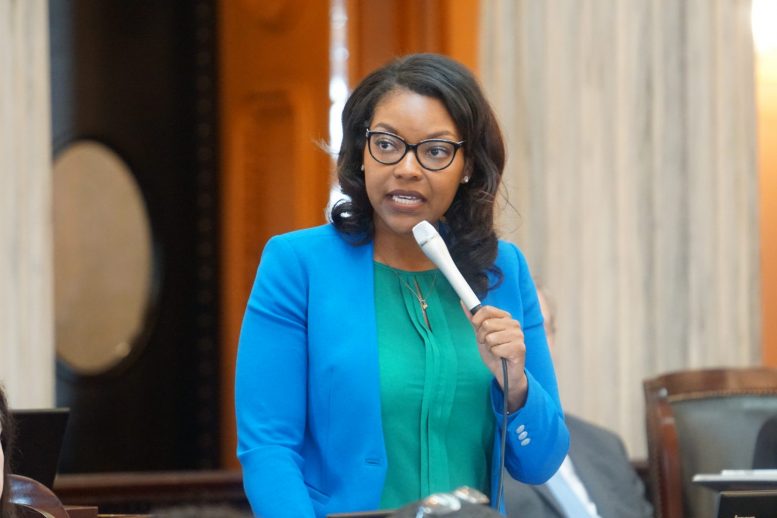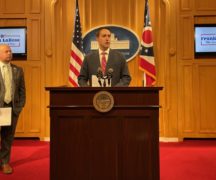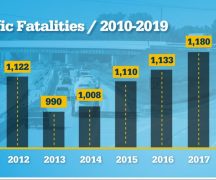By Jake Zuckerman| Tyler Buchanan
Nine months and 7,000 Ohioans’ deaths into the pandemic, House Republicans continue to shirk basic contact tracing protocols as three lawmakers have been infected with the new coronavirus in a week, the ranking Democrat alleged in an interview Monday.
Minority Leader Emilia Strong Sykes, D-Akron, said the House Speaker’s Office is mum after at least three lawmakers contracted COVID-19 in the last week.
She said Democrats are only learning of cases among Republican lawmakers if the infected person happens to call a Democrat, who then informs Sykes. Sykes then writes a memo to members and staff.
Typically, contact tracers with a public health department would determine whether an infected person had any close contacts and then notify those people without divulging the identity of the infected person.
“Contact tracing is very important, and you have a very small window of time to intervene in order to stop the spread,” Sykes said. “The failure of Republican leadership to recognize this, and to treat it as a burden or nothingburger is really doing a disservice to anyone who works in and around the statehouse.”
The list of known, currently infected lawmakers includes:
- Rep. John Patterson, D-Jefferson. Patterson confirmed his positive test in an interview with the Ohio Capital Journal.
- Rep. Rick Carfagna, R-Genoa. Carfagna wrote of his positive test and illness in a Facebook post.
- A third House Republican who Sykes declined to identify, citing privacy concerns.
It’s unclear what contact tracing, if any, the Ohio House of Representatives is conducting. Taylor Jach, a spokeswoman for Speaker Bob Cupp, R-Lima, did not respond to emails. In a statement to another media outlet, Jach confirmed two House Republicans tested positive.
Jach said “it is not believed” they were exposed at the statehouse and that Tuesday’s sessions would proceed as usual.
The three infected lawmakers attended multiple committee hearings and floor sessions last week prior to testing positive. The hearings are attended by members of the media, lobbyists and citizens who come to testify on various pieces of legislation.
The legislative chamber has no system in place to document who all is present in each hearing room, raising questions about how thorough any contact tracing effort could be.
“It’s just destined to be an outbreak. And it’s totally preventable,” Sykes said. “That’s the thing about this. This doesn’t have to happen.”
Despite the positive tests, the Ohio Statehouse continues to operate as normal with a few weeks left in the legislative term.
That differs from other state legislatures. The Arizona legislature canceled its sessions this week after members met with Rudy Giuliani, a lawyer and former New York City mayor representing the president in his quest to overturn the presidential election, who is reportedly hospitalized with COVID-19. County health officials in Michigan reportedly ordered lawmakers exposed to Giuliani at a hearing earlier this month to quarantine.
Sykes said the Ohio General Assembly is doing the opposite.
“They shut down operations for the week,” she said of the Arizona legislature. “This morning alone, I got three new committee notices. They’re ramping up activities. They’re doing everything wrong.”
The CDC advises that people infected with the new coronavirus can spread COVID-19, the disease it causes, both before and after exhibiting symptoms — that’s not to mention the 20% to 40% of infections that yield no symptoms. Those exposed to the virus are recommended to quarantine for 10 days, or seven days if they test negative.
Another Ohio Democrat has spent months urging Republican leadership to embrace a safer way of carrying out committee hearings. State Rep. Brigid Kelly of Cincinnati sent the speaker’s office letters in August and September requesting that he allow committees to field testimony by virtual means.
Under the current rules, those wishing to testify must visit the Ohio Statehouse and address committee members in person. They can also submit written testimony, though there is no guarantee lawmakers will read it and this option comes without the opportunity to answer questions from members in real time.
Kelly argued virtual testimony would allow citizens the opportunity to participate without having to face COVID-19 health risks or potentially put others present at risk.
The Cincinnati lawmaker told the Ohio Capital Journal on Monday she now intends to seek more significant changes through a pair of resolutions to be introduced this week. These resolutions will ask for entire committee hearings and floor sessions to be held virtually in order to prevent further spread of the virus.
She noted the House’s Economic Recovery Task Force met exclusively through video chat during the spring before any member had tested positive. Other government entities have conducted meetings virtually as well, such as the Ohio Controlling Board.
“This is an exceptional time and an exceptional circumstance,” Kelly said.
On multiple occasions, Republicans have voted down a requirement that lawmakers wear masks while conducting Statehouse business. The Ohio mask requirement in public places does not apply to the legislative branch.
Including the recent three, a total of eight lawmakers are known to have tested positive for COVID-19 in 2020:
- Rep. Stephanie Howse, D-Cleveland
- Sen. Frank Hoagland, R-Mingo Junction
- Sen. Tina Maharath, D-Columbus (twice)
- Sen. Bob Peterson, R-Washington Court House
- Rep. Joe Miller, D-Amherst
- Rep. Rick Carfagna, R-Genoa Twp.
- Rep. John Patterson, D-Jefferson
- Unknown House Republican
***
Governor says infection rate “not sustainable” for Ohio hospitals
After weeks of rocketing upward, the daily number of coronavirus infections in Ohio just might be leveling off.
But Gov. Mike DeWine and some of the state’s top health officials on Monday said that’s not good enough. If Ohioans keep getting infected at the rate they are, hospitals will have to take increasingly dire steps to deal with the situation.
“These numbers are not sustainable. Nobody thinks they are,” DeWine said. “Even if we’re flat (in the number of new infections) we’re filling up our hospitals.”
The Ohio Department of Health on Monday reported 9,275 new infections over the previous 24 hours, along with 336 new coronavirus hospitalizations. Ohio also crossed another somber milestone when the health department reported 63 more deaths, bringing the total to 7,022 since the beginning of the pandemic. READ MORE





